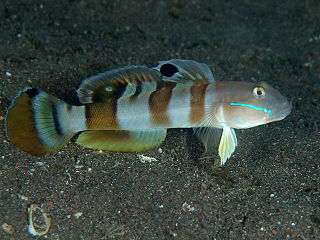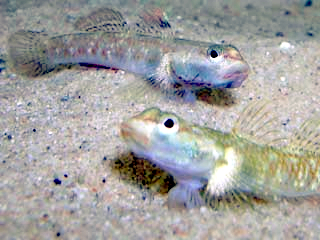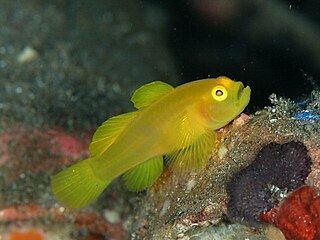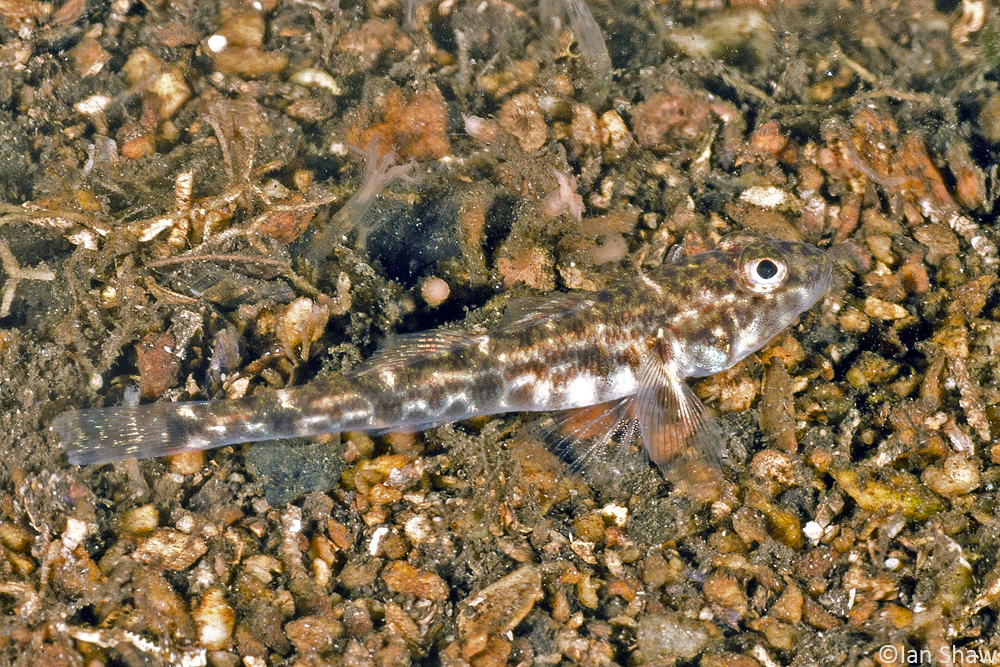
Dartfishes are a group of fish, formerly considered to be a subfamily, Ptereleotrinae, of goby-like fishes in the family Microdesmidae of the order Gobiiformes, Authorities now consider the species in the family Microdesmidae are within the Gobiidae, although the researchers do not define the taxonomic status of this grouping within that family. They are saltwater fish.

Exyrias is a genus of gobies mostly native to marine waters of the Indian Ocean and the western Pacific Ocean with one freshwater species (E. volcanus) known from the Philippines.

Valenciennea is a genus of small, bottom-dwelling fish in the family Gobiidae. They are found over sandy bottoms, often at coral reefs in the Indo-Pacific. The members of the genus tend to rest directly on the substrate for extended periods of time. While this is a common behavior for members of the family, this genus also float motionless directly above the substrate, which is why they are sometimes called glider gobies. Their resting behavior has resulted in the vernacular name "sleeper gobies", which invites confusion with the related family Eleotridae. The members of this genus are known to be carnivorous sand-sifters; to eat, they simply engulf entire mouthfuls of sand which they expel through their gills. Specialized structures in their gills filter small crustaceans and worms as the sand is expelled. It is this specific trait that makes some members of the genus attractive to the marine aquarist, and they are often introduced into a marine aquarium for sand-sifting. Some of the species are known to be monogamous. The genus was named after notable French zoologist Achille Valenciennes. These fish are difficult to keep in a tank. Tanks with plenty of live sand and live rock are recommended. Offer foods such as sinking shrimp pellets. Fish may die even if eating properly.

Acentrogobius is a genus of gobies native to marine, fresh and brackish waters of the coasts of the Indian Ocean and the western Pacific Ocean.

The sleepy goby is a species of fish in the Gobiidae family.

The Gobiiformes are an order of fish that includes the gobies. The order, which was previously considered a suborder of Perciformes, is made up of 2,211 species that are divided into seven different families. Phylogenetic relationships of the Gobiiformes have been elucidated using molecular data. Gobiiforms are generally small fish and are mostly marine (saltwater) fishes, but roughly 10% of the population inhabit fresh waters. This order is made up of mainly benthic or sand-burrowing fish. Benthic fish live on the bottom of a body of water. Like in most benthic organisms, gobiiforms do not have a gas bladder or swim bladder which keeps them from suspending in the water column, so they must stay on the bottom.

Amblygobius is a genus of fish in the family Gobiidae found in the Indian and Pacific Ocean.

True gobies were a subfamily, the Gobiinae, of the goby family Gobiidae, although the 5th edition of the Fishes of the World does not subdivide the Gobiidae into subfamilies. They are found in all oceans and a few rivers and lakes, but most live in warm waters. Altogether, the Gobiinae unite about 1149 described species in 160 genera, and new ones are still being discovered in numbers.

Amblyopinae is a subfamily of elongated mud-dwelling gobies commonly called eel gobies or worm gobies; it has been regarded as a subfamily of the family Gobiidae, while the 5th edition Fishes of the World classifies it as a subfamily of the family Oxudercidae. The members in the subfamily have two dorsal fins that are connected by a membranous structure and their eyes are highly reduced in size. They are usually pink, red, or purple in coloration.

Asterropteryx is a genus of fish in the family Gobiidae found in the Indian and Pacific Ocean.

Grallenia is a genus of fish in the family Gobiidae native to the western Pacific Ocean.

Hazeus is a genus of gobies, from the family Gobiidae, native to the Red Sea, the Indian Ocean and the northwestern Pacific Ocean.

Lubricogobius is a genus of fish in the family Gobiidae found in the Pacific Ocean.

Nesogobius is a genus of goby native to the coastal waters of Australia.
Sueviota is a genus of fish in the family Gobiidae native to the Indian and Pacific Ocean.

Fusigobius signipinnis, commonly called flasher sandgoby or signal goby among various vernacular names, is a species of marine fish in the family Gobiidae.
Navigobius is a genus of fish in the family Microdesmidae native to the Indo-Pacific Ocean.

Oxymetopon is a genus of fish formerly classified in the family Microdesmidae but now classified in the Gobiidae. They are native to the western Pacific Ocean. They are sometimes called ribbon-gobies.
Biendongella is a genus of fish in the subfamily Gobionellinae native to the South China Sea. The generic name is formed by adding the diminutive suffix ella to the Vietnamese name for the South China Sea, Bien Dong.

Psammogobius pisinnus, the sandslope goby, is a species of goby in the family Gobiidae from Australia and New Guinea.



















